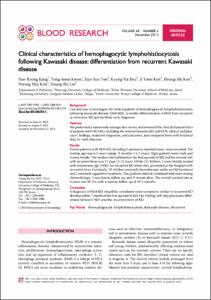Clinical characteristics of hemophagocytic lymphohistiocytosis following Kawasaki disease: differentiation from recurrent Kawasaki disease
- Keimyung Author(s)
- Kim, Ji Yoon; Kim, Heung Sik
- Department
- Dept. of Pediatrics (소아청소년학)
- Journal Title
- Blood Research
- Issued Date
- 2013
- Volume
- 48
- Issue
- 4
- Abstract
- Background : Our aim was to investigate the clinical pattern of hemophagocytic lymphohistiocytosis following Kawasaki disease (HLH-KD), to enable differentiation of HLH from recurrent or refractory KD and facilitate early diagnosis.
Methods : We performed a nationwide retrospective survey and reviewed the clinical characteristics of patients with HLH-KD, including the interval between KD and HLH, clinical and laboratory findings, treatment responses, and outcomes, and compared them with historical data for both diseases.
Results : Twelve patients with HLH-KD, including 5 previously reported cases, were recruited. The median age was 6.5 years (range, 9 months-14.7 years). Eight patients were male and 4 were female. The median interval between the first episode of KD and the second visit with recurrent fever was 12 days (3-22 days). Of the 12 children, 2 were initially treated with intravenous IgG (IVIG) for recurrent KD when they presented at the hospital with recurrent fever. Eventually, 10 children received chemotherapy under an HLH protocol and 2 received supportive treatment. Two patients died of combined infections during chemotherapy, 1 was lost to follow up, and 9 remain alive. The overall survival rate at 4 years was 81.1% with a median follow up of 45.1 months.
Conclusion : A diagnosis of HLH-KD should be considered when symptoms similar to recurrent KD develop within 1 month of the first episode of KD. Our findings will help physicians differentiate between HLH and the recurrent form of KD.
Keywords: Hemophagocytic lymphohistiocytosis, Kawasaki disease, Recurrent
Go to:
INTRODUCTION
Hemophagocytic lymphohistiocytosis (HLH) is a systemic inflammatory disorder characterized by uncontrolled histiocytic proliferation, hemophagocytosis, macrophage activation, and up-regulation of inflammatory cytokines [1, 2]. Macrophage activation syndrome (MAS) is a subtype of HLH, recently classified as secondary or reactive HLH (RHLH) [3]. RHLH can occur secondary to underlying systemic diseases such as infection, immunodeficiency, or malignancy and to autoimmune diseases such as systemic-onset juvenile idiopathic arthritis [4], or Kawasaki disease (KD) [1, 5-11].
Kawasaki disease causes idiopathic panarteritis in infants and young children, predominantly affecting medium-sized vessels such as the coronary arteries. There are no specific laboratory tests for KD; therefore clinical criteria are used to diagnose it. The clinical criteria include prolonged fever (for more than 5 days), and at least 4 of the following signs: bilateral non-purulent conjunctivitis, cervical lymphadenopathy, polymorphous skin rash, oral or lip erythema, and edema or desquamation of the palms and finger tips [12]. It is well known that in young infants, KD may manifest with incomplete clinical signs [13]. A differential diagnosis between HLH and KD can be very difficult, as they are characterized by similar signs and symptoms. This is particularly so in cases of recurrent KD, with patients typically returning to the hospital with prolonged fever.
To date, there have been no clinical studies investigating the clinical spectrum of HLH-KD. Therefore, our goal was to estimate the incidence, clinical characteristics, and outcomes of HLH-KD in a nationwide survey of all members of the Korean Society of Pediatric Hematology-Oncology (KSPHO). Another goal was to investigate the clinical features that differentiate HLH from recurrent or refractory KD, to enable early diagnosis.
- Publisher
- School of Medicine
- Citation
- Young-Ho Lee et al. (2013). Clinical characteristics of hemophagocytic lymphohistiocytosis following Kawasaki disease: differentiation from recurrent Kawasaki disease. Blood Research, 48(4), 254–257–254–257. doi: 10.5045%2Fbr.2013.48.4.254
- Type
- Article
- ISSN
- 2287-979X
- Appears in Collections:
- 1. School of Medicine (의과대학) > Dept. of Pediatrics (소아청소년학)
- 파일 목록
-
-
Download
 oak-aaa-00652.pdf
기타 데이터 / 1.42 MB / Adobe PDF
oak-aaa-00652.pdf
기타 데이터 / 1.42 MB / Adobe PDF
-
Items in Repository are protected by copyright, with all rights reserved, unless otherwise indicated.